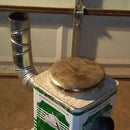Introduction: Wire Stripping Oven
Recently the Golf Club where my brother works as a Greens assistant upgraded the control systems for the watering of the golf course. This left a lot of copper wiring which would have been trashed. My brother bundled it up and kept it. At the beginning of this year, April to be exact he gave me several bundles of wire a burlap bag, and one of those big plastic totes with wire. 0,6,8,10,12,14 gauge. All together at the end of stripping the wire I made about $400.00 Canadian. Price for clean shinny copper at the time $3.35 a pound, price for cladded copper that is with the plastic on it 85 cents a pound. A bloody giveaway at that price.
Step 1: The Wire Stripper
Copper shinny copper poor man's gold what to do, what to do, Google to the rescue - entered copper wire stripper, many designs, I can't weld, don't have a welder, prefer to work with wood, plastic and sheet metal, made my own, idea and concept good, unit did not meet my expectations. See picture will not describe it.
Step 2: In Comes the Heat
The light bulb in da brain clicked on, what if I used heat to soften the plastic. AHA I already have the heat source, my shop oven. So I tried it, worked to soften the plastic but the wires were bent, by the time i untangled a wire and attached to vise grip it was cooling off.Was working in the garage in April, a bit cold. So what now genius? Disassemble the shop oven and create wire stripping oven.
Step 3: The Wire Stripping Oven
MATERIALS USED
1 shop oven
some oven wire - HIGH TEMP- the stuff with braiding
oven connectors- HIGH TEMP
some sheet metal
some metal screws
some wire mesh
some plywood
and other assorted things as needed
TOOLS
drill - cordless or corded will do
drill bits
pliers
metal shears
screw drivers
hammer
After disassembling the shop oven I checked my lumber stash that is the picture of my garage roof. I keep my found lumber there. I found some pieces of 3/4 inch by 9 inch 36 inch plywood there.Perfect size not much cutting needed.
I cut the heating element holder in half so that it would fit in the new box. One set of elements on top and one set in the bottom, just like a toaster oven.
Step 4: Let the Stripping Begin
As can be seen from the picture the wire was all tangled and bent. So I made my life easier by untangling and straightening the wires, cut the long ones to size to fit the oven. The oven is about 9x9x32 rectangular.After loading the wire in the oven, turned on the heat at low point, the plastic softened and I could remove the plastic cover without much effort.
Some effort needed but in the end I got some cash, and a new shop oven, more compact and i can process longer pieces of plastic material, even 6x32 inch pipes.




